Barrel marking image for 1945 Colt M1911 with Type 6, with or without “Colt 45 Auto” marking.
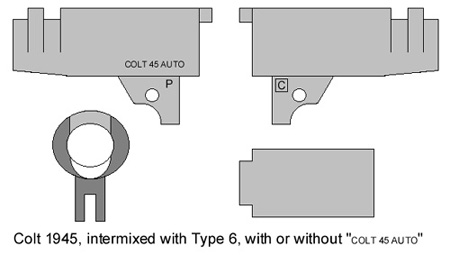
Keyword: 1911
Barrel marking image for 1945 Colt M1911 with Type 6, with or without “Colt 45 Auto” marking.

Detail image of what barrel markings you might expect to see on a Colt M1911 barrel in the serial number range of 450,000 to 710,000.
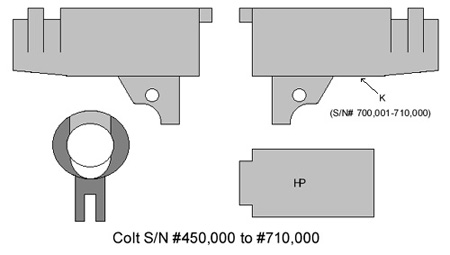
This diagram provides some of the commonly found markings on the Colt M1911 pistol in the serial number range of 85,000 to 450,000.
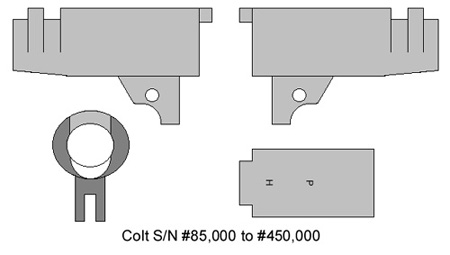
These are the typical barrel markings on a Colt M1911 from about serial number 25,000 to 120,000.
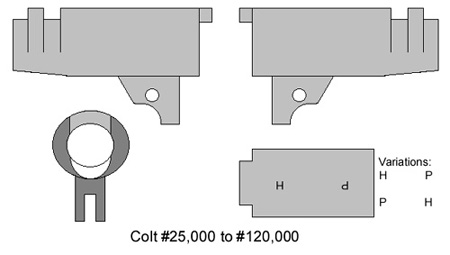
Image of Colt M1911 barrel markings from about serial number 6,500 to 25,000.
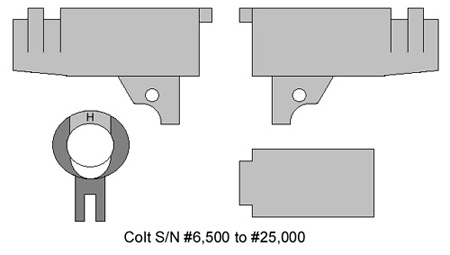
This is an image of the markings on the barrel of Colt M1911 pistols to about serial number 6,500.
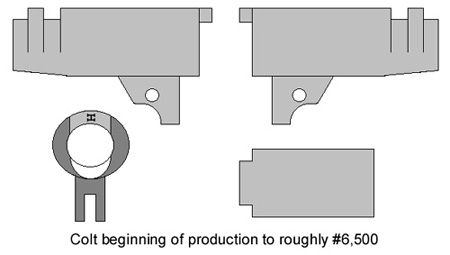
By David L. Velleux
Table of Contents
I Basic Statistics
II Development History
III The Thompson-LaGarde Cadaver Tests of 1904
IV Service History
V Pistol Picture
VI Conflict Use
Statistics
| United States Pistol, Caliber .45, M1911 |
|
|---|---|
| Date Adopted: | 28 March 1911 |
| Length: | 216mm (8.50″) |
| Weight, empty: | 1.13kg (2.49 lbs.) |
| Caliber: | .45 Ball M1911 |
| Muzzle Velocity: | 253mps (830FPS) |
| United States Pistol, Caliber .45, M1911A1 |
|
| Date Adopted: | 20 May 1924 |
| Length: | 216mm (8.50″) |
| Weight, empty: | 1.13kg (2.49 lbs.) |
| Caliber: | .45 Ball M1911 |
| Muzzle Velocity: | 253mps (830FPS) |
| U. S. Pistol, General Officers’, Caliber .45, M15 |
|
| Date Adopted: | 1972 |
| Length: | 200mm (7.90″) |
| Weight, empty: | 1.03kg (2.27 lbs.) |
| Caliber: | .45 Ball M1911 |
| Muzzle Velocity: | 245mps (800FPS) |
The United States Pistol, Caliber .45, M1911and the United States Pistol, Caliber .45, M1911A1 were developed based on two key factors:
During the early 1890s, George Borchardt, a German-born, naturalized American working for a German arms maker, designed and developed a semi-automatic pistol using a toggle-bolt action, which sold in very modest numbers in Europe.1 A few years later, Georg Luger, another German-born, naturalized American working for the German arms firm Deutsche Waffen und Munitionfabrik (DWM), refined Borchardt’s design and marketed this pistol, which was chambered for a bottlenecked 7.65mm(.30 caliber) round developed by Luger, to the militaries of many countries.2
On the other side of the Atlantic Ocean, John M. Browning was designing pistols in his Utah workshop. When he tried selling his designs to his main purchaser, the Winchester Repeating Arms Company of New Haven, Connecticut, Winchester turned him down, preferring to concentrate on producing his rifle designs. Browning then approached the Colt’s Patent Firearms Manufacturing Company of Hartford, Connecticut, who immediately purchased the rights to his large caliber pistol designs. Colt desired a military contract and needed large caliber pistols to meet military requirements. Fabrique Nationale d’Arms de Guerre of Herstal-lèz-Liége, Belgium, bought the rights to Browning’s small caliber pistol designs.3 Patented in 1897, the first of Browning’s large caliber Colt-built designs, the Model 1900, was little more than an experimental pistol firing the Browning-developed .38 Automatic Colt Pistol (ACP) round from a seven-round detachable magazine. It met with only moderate commercial success, but some samples were purchased by the American military.4
In 1901, the U.S. Army bought about 1000 Luger pistols for troop trials, where they were immediately put to use in field tests. However, the standard .38 Long Colt-chambered M1889 series revolvers of that period were not acquitting themselves well enough for the troops’ liking during campaigns like the Philippine Insurrection and the feeling carried over to the 7.65mm Lugers.5 But in Germany, the Wehrmacht (Armed Forces) liked the Luger pistol, but not the caliber. Military ordnance officers asked for a more powerful round, so in 1902, Luger changed the bottlenecked case to a tapered straight wall design and substituted a larger 9mm-diameter bullet into the new case, creating the 9mm Parabellum round.6 Across the Atlantic the same year, Colt marketed a variation of the Model 1900, the Model 1902 Military, which used a slightly shortened firing pin. The new firing pin acted like a safety, to prevent accidental firing since the pin itself was shorter than the channel it rested in was. Only a solid strike by the pistol’s hammer overcame the inertia of the firing pin to fire a round. While the U.S. Army purchased just a few evaluation samples, the Model 1902 sold very well on the civilian market until production ended in 1929.7
In April 1903, the U.S. Army asked to trade fifty (50) 7.65mm Luger pistols for fifty (50) of the new 9mm version (Georg Luger himself brought the new samples into the U.S the next month) and troop trials began again.8 In 1904, the Swiss military and the German Kriegsmarine (Navy) adopted the new 9mm Luger. Four years later, the German Heer (Army) adopted it as the Pistole-08, or P-08, which went on to become one of the most produced and copied handguns in military history.9
III. The Thompson-LaGarde Cadaver Tests of 1904
(Author’s Note: The following footnoted paragraphs are based on the article, The Holes in Stopping Power Theory, written by Leon Day. The 1904 live animal and medical cadaver testing may give concern to those who think it was, according to today’s standards, both “barbaric” and highly unscientific. But in the interest of furthering the study of military arms, the testing results are basically presented as Mister Day previously wrote them. Some may find these paragraphs objectionable, but the full story must be told without embellishment and without withholding any pertinent data, no matter how gruesome it may be…)
In 1901, President Theodore Roosevelt appointed Brigadier General William Crozier as Chief of Army Ordnance. In 1904, Crozier assigned two individuals, Captain John T. Thompson of the Infantry and Major Louis Anatole LaGarde of the Medical Corps, to investigate and recommend which caliber should be used in any new service handgun. At the Nelson Morris Company Union Stockyards in Chicago, Illinois, they tested several types of handguns, calibers and bullet styles against both live cattle and medical cadavers.10 Before continuing, some definitions about the types of animals and the bullet types used in the testing are needed:
Animal Terms and Definitions
| Definition | Definition |
| Bull | Mature male bovine |
| Cow | Mature female bovine |
| Steer | Male bovine castrated before maturity |
| Stag | Male bovine castrated after maturity |
|
|
|
Bullet Terms and Definitions
| Term | Abbrv | Definition |
| Grains | Grs. | A measure of weight where 7000 grains equals 1 pound. |
| Feet Per Second | FPS | A measure of velocity in feet per second. |
| Foot-pounds | FPE | A measure of power of a fired bullet. |
| Lead Round Nose | LRN | Lead bullet with a rounded nose profile. |
| Full Metal Jacket | FMJ | Lead bullet almost completely covered in copper. |
| Flat Point | FP | Bullet having a blunt nose. |
| Hollow Point | HP | Bullet with a cavity in front for rapid expansion on impact. |
|
|
||
The first day of live animal testing involved shooting eight head of cattle with rounds fired at selected target areas while timing the events. The time scale in the tables below is shown in minutes and seconds. The testing went as follows:
| No. | Caliber | Animal | Time(mm:ss)/Results |
| 1 | .476 Eley Weight: 288 grs. Style: LRN Velocity: 729 FPS Energy: 340 FPE |
Stag Weight: 1200 – 1300 lbs. |
00:00 – Two shots into lungs; rounds impacted 4″ apart. 04:00 – Animal still on feet. 05:00 – Dead. |
|
|
|||
| 2 | 7.65mm Luger Weight: 92.5 grs. Style: FMJ-FP Velocity: 1420 FPS Energy: 340 FPE |
Stag Weight: 1200 – 1300 lbs. |
00:00 – Shot through lungs left to right. 00:30 – Dead. |
|
|
|||
| 3 | .38 Long Colt Weight: 148 grs. Style LRN Velocity: 723 FPS Energy: 191 FPE |
Stag Weight: 1200 lbs. |
00:00 – Shot through lungs; animal jumped around. 02:30 – Shot through lungs; animal jumped around. 03:20 – Shot again; staggered 30 second. 03:50 – Dead. |
|
|
|||
| 4 | .476 Eley Weight: 288 grs. Style: LRN Velocity: 729 FPS Energy: 340 FPE |
Stag Weight: 1300 lbs. |
00:00 – One shot through intestines. 02:00 – One shot through intestines again. 03:10 – One shot through intestines again. 06:10 – Shot twice in the head. 07:15 – Shot in the ear. 08:15 – Shot behind the ear. 08:15+ – Killed by four hammer blows to head; no round reached brain. |
|
|
|||
| 5 | .38 ACP Weight: 130 grs. Style: FMJ-RN Velocity: 1107 FPS Energy: 354 FPE |
Steer Weight: 1100 lbs. |
00:00 – Shot through lungs. 01:00 – Shot through lungs again. 01:35 – Shot through lungs again. 01:35+ – Killed by 4 hammer blows to head. |
|
|
|||
| 6 | .45 Long Colt Weight: 220 grs. Style: LHP Velocity: 700 FPS Energy: 239 FPE |
Cow Weight: 1000 lbs. |
00:00 – Shot through lungs. 01:00 – Shot through lungs again. 02:00 – Falling; shot twice in abdomen. 02:00+ – Dead. |
|
|
|||
| 7 | .45 Long Colt Weight: 250 grs. Style: L-FP Velocity: 720 FPS Energy: 288 FPE |
Bull Weight: 1300 lbs. |
00:00 – Shot through lungs. 01:00 – Shot through lungs again. 02:00 – Shot through lungs again. 02:35 – Shot in abdomen; fell, then got up. 02:45 – Shot in abdomen; fell; got up; fell, but tried staying on its feet for 70 seconds. 03:55 – Killed with hammer. |
|
|
|||
| 8 | .455 Man-Stopper Weight: 218.5 grs. Style: L-HP Velocity: 801 FPS Energy: 312 FPE |
Stag Weight: 1250 lbs. |
00:00 – Shot through lungs. 01:00 – Shot through lungs again. 02:10 – Shot through intestines. 03:15 – Shot through intestines again. 04:15 – Killed with hammer. |
|
|
|||
Neither Thompson nor LaGarde could have been very satisfied with the first day’s results, so for the second day of testing, they changed the testing procedure completely, deciding to shoot the animals as rapidly as possible until either they fell or ten shots were fired. The second day of testing went as follows:
| No. | Caliber | Animal | Results |
| 9 | .45 Long Colt Weight: 250 grs. Style: L-FP Velocity: 720 FPS Energy: 288 FPE |
Cow Weight: 950 lbs. |
Shot through lungs; fell after sixth shot. |
|
|
|||
| 10 | 7.65mm Luger Weight: 92.5 grs. Style: FMJ-FP Velocity: 1420 FPS Energy: 340 FPE |
Cow Weight: 950 lbs. |
00:00 – Shot through lungs three times. 01:00 – Jam; shot five times in lungs. Reloading break. Shot twice. Killed with hammer. |
|
|
|||
| 11 | 9mm Luger Weight: 123.5 grs. Style: FMJ-FP Velocity: 1048 FPS Energy: 301 FPE |
Cow Weight: 1100 lbs. |
00:00 – Shot twice through lungs. 01:00 – Jam; shot six times in lungs. Reloading break. Shot twice in abdomen and twice in lungs. Killed with hammer. |
|
|
|||
| 12 | .476 Eley Weight: 288 grs. Style: LRN Velocity: 729 FPS Energy: 340 FPE |
Bull Weight: 1100 – 1150 lbs. |
00:00 – Shot six times through lungs. Dead after sixth shot. |
|
|
|||
| 13 | .455 Man-Stopper Weight: 218.5 grs. Style: L-HP Velocity: 801 FPS Energy: 312 FPE |
Bull Weight: 1150 lbs. |
00:00 – Shot five times in lungs. 00:30 – Shot three times in lungs. 01:30 – Shot twice in lungs; animal began to fall, then shot twice in abdomen. |
|
|
|||
During the cadaver testing, the bodies were hung by the head and were shot at from distances of 3 yards, 37.5 yards and 75 yards. The target areas were fleshy areas, bone ends and bone shafts.11 If a round struck a fleshy area, only the hollow point rounds produced a bare minimum of sway, but if a bone end was struck, all the rounds showed similar results, though the .455 Man-Stopper and the .476 Eley were just slightly better.12 When a round struck a bone shaft, the sway produced enabled Thompson and LaGarde to give each round a subjective measurement; in short, they watched the body sway and simply gave it a number value for comparison purposes without setting a standard to compare it to.13 The table below details these subjective measurements:
| Caliber | Value |
| .38 Long Colt, L-RN | 50 |
|
|
|
| .38 ACP, FMJ-RN | 60 |
|
|
|
| .30 Luger, FMJ-FP | 60 |
|
|
|
| .30 Luger, FMJ-FP tip filed |
60+ |
|
|
|
| .38 ACP, SP | 70 |
|
|
|
| .38 ACP, FMJ-RN filed |
70 |
|
|
|
| 9mm Luger, FMJ-FP | 80 |
|
|
|
| .45 Long Colt, L-FP | 80 |
|
|
|
| .45 Long Colt, L-HP | 85 |
|
|
|
| .455 Man-Stopper | 87 |
|
|
|
| .476 Eley, L-RN | 100 |
|
|
|
Based upon the data they gathered, Thompson and LaGarde stated, “the Board was of the opinion that a bullet, which will have the shock effect and stopping effect at short ranges necessary for a military pistol or revolver, should have a caliber not less than .45”. But they also said, “…soldiers armed with pistols or revolvers should be drilled unremittingly in the accuracy of fire” because most of the human body offered “no hope of stopping an adversary by shock or other immediate results when hit.”14
(Author’s Opinion: Thompson and LaGarde did what any soldier would do when carrying out orders from a superior where an inconclusive answer would be intrepeted as failure: they gave a reasonable recommendation even though the data did not support the conclusion. In short, they LIED to at least give some results. )
In 1905, Colt asked John Browning to improve his Model 1902 Military. As his first task, Browning first developed a .45 caliber round firing a 200-grain bullet. Later that year, Colt unveiled the Model 1905, a .45 caliber pistol quite similar in appearance to its precursors.
Trials were scheduled for September 1906, but some delays caused by the sample .45 cartridges provided by the Ordnance Department forced the Secretary of War to issue a Special Order dated 28 December 1906 signifying the U.S. Army was ready to begin testing handguns again and created a list of requirements for the new handgun to meet.15 The main requirements, of those put forth, were as follows:
In January 1907, the competitors for this first trial submitted their handguns. The competitors included Colt, Savage Arms Company, DWM/Luger, Knoble, Bergmann, White-Merril and the Webley Automatic Revolver. The U.S. Army had purchased about 200 Model 1905s for testing. Many designs were rejected quickly, so only the pistols from Colt, DWM and Savage remained, but each firm’s pistol still had problems in need of correction.16 But this action caused DWM to feel their pistol was being used by the Army as a “whipping boy” for both the Colt and Savage designs and withdrew their pistol from further testing in early 1908.17 At this point, the Army decided to schedule a yearlong field trial beginning in late 1908, after Colt and Savage had fixed the problems previously noted. Savage at first declined since the firm was not ready for production, but managed to return to the competition.18
By November 1908, Colt and Savage provided new pistols with the requested modifications to the Chief of Ordnance for inspection. Defects due to parts interchange and function were observed and both companies acknowledged requests for improvement. In March 1909, the revised pistols were issued for field trials to Troop I, 3rd Cavalry, Fort Wingate, New Mexico; Troop G, 6th Cavalry, Fort Des Moines, Iowa; and Troop G, 11th Cavalry, Fort Ogelthorpe, Georgia. Testing, reports and repairs/improvements occurred over the next nineteen months, with both firms making changes to their pistols in the interim.19
By this time, John Browning decided to prove the superiority of his design himself, so he went to Hartford to personally supervise the production of the gun. There he met Fred Moore, a young Colt employee, who worked in close cooperation with Browning, trying to ensure each test gun was simply the best possible.
In November 1910, the second competitive range test was held on weapons improved as a result of field trials, but problems were still noted with both designs. Both firms went back to the drawing board preparing for the next round of testing. On 15 March 1911, an endurance test was held. The test involved having each gun fire 6000 rounds, with cleaning after every one hundred shots fired, then allowing them to cool for 5 minutes. After every 1000 rounds, the pistol would be cleaned and oiled. After firing those 6000 rounds, the pistols were then tested with deformed cartridges, rusted in acid or submerged in sand and mud.20 By the end of the test, the Savage design suffered over 37 incidents of malfunction or breakage; the Colt did not have one. On 23 March 1911, the evaluation committee’s report stated, “Of the two pistols, the board was of the opinion that the Colt is superior, because it is more reliable, more enduring, more easily disassembled when there are broken parts to be replaced, and more accurate.”21
On 28 March 1911, the U.S. Army finally adopted the Browning-designed, Colt-produced pistol as the United States Pistol, Caliber .45, Model 1911, beginning a relationship that would last until 14 January 1985.
In 1914, after a few years service, the Army requested and received several small changes to the M1911, with the most noticeable change being the lengthening of the hammer spur to help cock the pistol with only one hand. Also this year, the Norwegian military adopted the M1911 and began licensed production of the pistol.22 Springfield Armory of Springfield, Massachusetts also began producing the M1911 in this year under a contract provision stating Springfield Armory was able to build one pistol for every two purchased from Colt after the first 50,000 M1911s were produced.23
When the United States entered World War I, the military was in dreadfully short supply of types of small arms. This meant the M1911 was put into full production, but also other small arms were acquired to fire the M1911 Ball round. Both Colt and Smith & Wesson adapted their large frame civilian revolvers to do this round and both were adopted as the United States Revolver, Caliber .45, M1917. Additionally, several other firms, including Remington Arms-Union Metallic Cartridge Company(UMC) of Ilion, New York, National Cash Register Company, Savage, Burroughs Adding Machine Company, Winchester Repeating Arms Company, Lanston Monotype Company, North American Arms Company and Caron Brothers of Montrael, Quebec, Canada, were contracted by the U.S. military to produce the M1911. Only Remington-UMC was able to produce any significant numbers of pistols before the war ended in 1918, but most of their deliveries of M1911 pistols occurred in 1919 after hostilities ended.24
During World War I, it was noticed the lengthened hammer spur, combined with the short grip safety tang, caused a condition where the webbing between a firer’s thumb and forefinger was pinched during firing, sometimes with painful results. A civilian, Marcellus Rambo, suggested several changes to make the M1911. These changes were as follows:
With these changes, the Army adopted the revised pistol on 20 May 1924 and renamed the M1911 as the M1911M1, and later the M1911A1. It should be noted no mechanical changes have ever been made to the pistol since first adopted by the military.25
In the early 1940s, the Army decided to run an experiment to find out what problems would be encountered in producing the M1911/M1911A1 by a firm without any prior firearms manufacturing experience. The Singer Sewing Machine Company of Worcester, Massachusetts was selected and built only 500 pistols before the start of World War II caused the production machinery to be transferred to the Ithaca Gun Company of Ithaca, New York.26
During the war, Colt, Ithaca, the Remington-Rand Company of Syracuse, New York and the Union Switch & Signal Company of Swissvale, Pennsylvania produced the M1911A1. The only change made to the M1911A1 during the war was a shift to brown plastic grips, replacing the diamond-checked walnut grips of the M1911.27 By the time the war ended in 1945, nearly 2.7 million M1911 and M1911A1s had been purchased by the military. Even the adoption of the M1 Carbine in 1941, an arm intended to replace the M1911 in the hands of many support personnel, could not alleviate the military’s need for the M1911/M1911A1 pistol.28
After the war, the formation of North Atlantic Treaty Organization (NATO) caused the American military to look at standardizing its small arms with other countries in the alliance. But the Army pointed out most of its pistols were only a few years old and it would be a waste of money to throw them away, so the idea was forgotten.29 In the late 1950s, the Army and the Air Force began to experiment with match-grade .45-caliber competition pistols using the M1911A1 as the basic foundation. Adding adjustable sights, modifying some parts and generally tightening the tolerances of the pistols resulted in handguns able to compete head-to-head at the topmost levels against the customized guns used by the best target shooters from across the United States and around the world.30
By the early 1970s, the Army decided to really do something for its General Officers in terms of personal protection. The M1908 Colt Pocket Hammerless pistols issued to General Officers since World War II had finally outlived its service life. To correct this situation, Rock Island Arsenal, Rock Island, Illinois began modifying the standard M1911A1. The pistol’s slide and barrel were shortened just over .75″(1.905cm) and the barrel had one locking lug removed. A full-length recoil spring guide was installed, as was an enlarged set of fixed sights. Checkered, walnut grip panels inlaid with a plate bearing the officer’s name replaced the standard pistol’s brown plastic grips. Adopted in 1972 as the United States Pistol, General Officers’, Caliber .45, M15, it is similar in both size and weight to the civilian Colt Combat Commander. The M15’s increased muzzle blast and recoil are a small price to pay for what is hoped to be a personal weapon of last resort.31
The last military modification of the M1911A1 came in the early 1980s. The United States Air Force wanted to issue its Office of Special Investigations (OSI) personnel something a little potent, but nearly as compact as a .38-caliber snub-nosed revolver. Starting with the basic M1911A1 acquired from the U.S. Navy as surplus, unserviceable weapons, the slide and barrel were shortened by .75″(1.905 cm). The frame was also shortened nearly .5″(1.27 cm), requiring a special six round magazine to be created, with a finger rest to create a better gripping surface for personnel with large hands. The front edge of the triggerguard was squared and the frontstrap stippled for better gripping. A ramp-type front sight was installed on the shortened slide and an ambidextrous safety was built and added to the pistols. Costing U.S. taxpayers less than $100 to rebuild, only a small number of these OSI pistols were built.32
By 1979, all the M1911s/M1911A1s in military inventories had been rebuilt many times over and were falling apart. Directed by Congress, the military searched for a replacement and on 14 January 1985, the Beretta Model 92F succeeded the M1911A1 as the standard pistol for the United States military.
The M1911 and the M1911A1 pistols were incredibly robust and durable. From the muddy trenches of “No Man’s Land” in the Meuse-Argonne Forest of Belgium during World War I to the steaming jungles of Viet Nam and beyond, these war-horses proved their worth. Probably the greatest testament to the .45 ACP round’s lethality came during World War I in the hands of a Tennessee pacifist named Alvin York. Then-Corporal York and his squad were pinned down by German machine-gun fire and had nearly emptied his M1917 Enfield rifle when six German soldiers rushed his position. Samuel K. Cowan recounted the event in his book, Sergeant York:
York “…selected as his first mark amongst the Germans the one farther away. He knew he would not miss the form of a man at that distance. He wanted the rear men to fall first so others would keep on coming at him and not stop in panic when they saw their companions falling, and fire a volley at him. He felt that in such a volley his only danger lay.
“They kept coming, and fell as he shot. The foremost man, and the last to topple, did not get 10 yards from where he started. Their bodies formed a line down the hillside…”33
After this action, York and his squad moved toward their own lines, capturing over eighty prisoners as they went along that day. For his bravery and courage under fire, Alvin York was awarded the French Croix de Guerre and the American Medal of Honor.
With seventy-four years passing between its adoption in 1911 and its “retirement” in 1985, both the M1911 and the M1911A1 were there as a goodly portion of this century’s world history was written. And the M1911 and the M1911A1 co-authored with American servicemen in writing much of it.
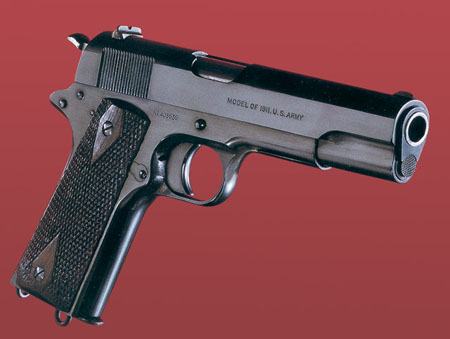
| Conflicts Used | |
| Conflict | Date |
|---|---|
| Philippine Insurrection | 1912 – 1916 |
| Nicaraguan Campaign | 1912 |
| Capture of Veracruz, Mexico | 1914 |
| Occupation of Haiti | 1915 – 1934 |
| Occupation of Dominican Republic | 1916 – 1924 |
| Pancho Villa Punitive Expedition | 1917 |
| World War I |
1917 – 1918 |
| Allied Occupation of Russia | 1918 – 1920 |
| Yangtze River Patrol Service | 1926 – 1927 1930 – 1932 |
| Occupation of Nicaragua | 1927 – 1933 |
| China Service | 1937 – 1941 |
| World War II | 1941 – 1945 |
| Korean War |
1950 – 1953 |
| Lebanon Landing | 1958 |
| Taiwan Straits | 1958 – 1959 |
| Quemoy and Matsu Islands | 1958 – 1963 |
| Berlin Crisis | 1961 – 1963 |
| Thailand Landing | 1962 |
| Cuban Missile Crisis | 1962 – 1963 |
| Congo | 1964 |
| Viet Nam War | 1965 – 1974 |
| Operation Eagle Pull (Cambodia) |
1975 |
| Operation Frequent Wind (South Vietnam) |
1975 |
| Mayagüez Rescue Operation (Cambodia) |
1975 |
| Iranian Hostage Rescue Attempt |
1980 |
| Lebanon Deployment | 1982 – 1983 |
| Operation Urgent Fury (Grenada) |
1983 |
Footnotes:
| 1 | Hallock, Kenneth R., Hallock’s .45 Auto Handbook, Kenneth R. Hallock, 1980. |
| 2 | Hallock, Kenneth R., ibid. |
| 3 | Hogg, Ian V., Pistols of the World, Third Edition, DBI Books Incorporated, 1992. |
| 4 | Hogg, Ian V., ibid. |
| 5 | Crossman, James, COL, Trials of the .45, American Rifleman, August 1985. |
| 6 | Hogg, Ian V., Military Small Arms of the Twentieth Century, Sixth Edition, DBI Books Incorporated, 1992. |
| 7 | Hogg, Ian V., Pistols of the World, Third Edition, DBI Books Incorporated, 1992. |
| 8 | Crossman, James, COL, Trials of the .45, American Rifleman, August 1985. |
| 9 | Hogg, Ian V., Military Small Arms of the Twentieth Century, Sixth Edition, DBI Books Incorporated, 1992. |
| 10 | Day, Leon, The Holes in Stopping Power Theory,Gun Digest, Thirty-seventh Edition, DBI Books Incorporated, 1983. |
| 11 | Day, Leon, ibid. |
| 12 | Day, Leon, ibid. |
| 13 | Day, Leon, ibid. |
| 14 | Day, Leon, ibid. |
| 15 | Hallock, Kenneth R., Hallock’s .45 Auto Handbook, Kenneth R. Hallock, 1980. |
| 16 | Hallock, Kenneth R., ibid. |
| 17 | Hallock, Kenneth R., ibid. |
| 18 | Hallock, Kenneth R., ibid. |
| 19 | Hallock, Kenneth R., ibid. |
| 20 | Hallock, Kenneth R., ibid. |
| 21 | Crossman, James, COL, Trials of the .45, American Rifleman, August 1985. |
| 22 | Hogg, Ian V., Military Small Arms of the Twentieth Century, Sixth Edition, DBI Books Incorporated, 1992. |
| 23 | Hallock, Kenneth R., Hallock’s .45 Auto Handbook, Kenneth R. Hallock, 1980. |
| 24 | Hallock, Kenneth R., ibid. |
| 25 | Hallock, Kenneth R., ibid. |
| 26 | Hallock, Kenneth R., ibid. |
| 27 | Hallock, Kenneth R., ibid. |
| 28 | Hogg, Ian V., Military Small Arms of the Twentieth Century, Sixth Edition, DBI Books Incorporated, 1992. |
| 29 | Hallock, Kenneth R., Hallock’s .45 Auto Handbook, Kenneth R. Hallock, 1980. |
| 30 | Hallock, Kenneth R., ibid. |
| 31 | Hallock, Kenneth R., ibid. |
| 32 | Karwan, Charles, Air Force Custom Combat .45 Auto, Gun Digest Book of Autoloading Pistols, DBI Books Incorporated, 1983. |
| 33 | Woodward, Todd, Colt .45 Automatic, Popular Mechanics, Hearst Publications, August 1995. |
| 1 | Found on Internet. | |
| 2 | Found on Internet at ColtAutos.Com. | |
| 3 | Found on Internet at ColtAutos.Com. | |
| 4 | Found on Internet at ColtAutos.Com. | |
| 5 | Found on Internet at ColtAutos.Com. | |
| 6 | Found on Internet at ColtAutos.Com. | |
| 7 | Found on Internet at ColtAutos.Com. | |
| 8 | Found on Internet at ColtAutos.Com. | |
| 9 | Velleux, David L., from personal collection. | |
| 10 | Velleux, David L., from personal collection. | |
| 11 | Hallock, Kenneth R., Hallock’s .45 Auto Handbook, Kenneth R. Hallock, 1980. |
Author: David
L. Velleux
Copyright © 1998. Article used by permission of the author
John E. Holbrook
In early July 1967 I was sent to South Vietnam to try to determine why many of the 500 lb. bombs being delivered by naval aircraft were not detonating. I had extensive experience with both conventional and nuclear weapons. The VC would dig up these duds, melt out the Amatol and use the explosive to manufacture crude but very effective anti-personnel booby traps. I was assigned an EOD (Explosive Ordnance Disposal) team and we would be escorted by whatever Army or Marine units were available for protection. We would remove the fuses and detonate the bombs.
On July 13, 1967, while on one of these missions, we were attacked by a force of approximately 50 Viet Cong. As the attack developed my M16A1 jammed, which left me unarmed. I came across a wounded Marine officer, Captain Eldon M. Martin lying in a rice paddy. Captain Martin, although severely wounded was alert and indicated that he was lying on an M14, which was under water and that he had a fully loaded .45 pistol in his holster.
As I removed the Colt M1911A1 .45 automatic (serial # 23002XX) from the Captain, I observed three VC armed with AK-47s moving toward me in a crouched position through the thick grass which was about 2 meters high. I waited until they were within about 4 meters from me. I rose to a kneeling position using the grass as a shield. I put the front sight of the Colt on the man on the left and pulled the trigger. The man in the middle went down! I had jerked the trigger and was very lucky to have gotten a hit. I then moved back to the man on the left, held my breath and fired again. This round hit the man on the left in the chest and he went down. The last man realized what was happening and began firing his AK in my direction. I could see the bullets hitting the water in front of me as he brought the AK up. I fired my third round which hit the magazine of the AK, then glanced down striking him in the right leg. As he spun around from the impact of the 230 grain bullet, I fired two more rounds one of which hit him in the temple just above the left eye. The gunfight was over!
This action lasted not more that 4 seconds and I got four hits with five rounds of GI 230 grain hardball from a pistol that had mud and water in it. All of these hits were one shot stops against three men armed with automatic weapons. God bless the .45 ACP.
I must thank my father, who was the Sheriff of San Patricio County, Texas during World War II. He carried a Colt Government Model and I was shooting the big Colt when I was 10. I was a very good shot with both pistol and rifle very early in life and took my first deer when I was 11. I must also thank John Browning and Colt for inventing and producing the finest combat pistol ever made, bar none. I believe that if I had been armed with a 9MM, both our names would be on the Vietnam Memorial Wall in Washington D.C.
Captain Martin, although badly wounded, survived the action. He insisted that I keep the Colt and I still have it. The greatest honor was when he named his first son after me in 1971. Unfortunately, Captain Martin died in 1991 of MLS. He was a good man, I miss him as I do all the fine young Americans who died in Vietnam.
After that action, I “lost” the M16 and acquired an M14, and I was in love.
John E. Holbrook
Chief Aviation Machinist Mate
U.S. Navy (Retired)
SN 361-43-78